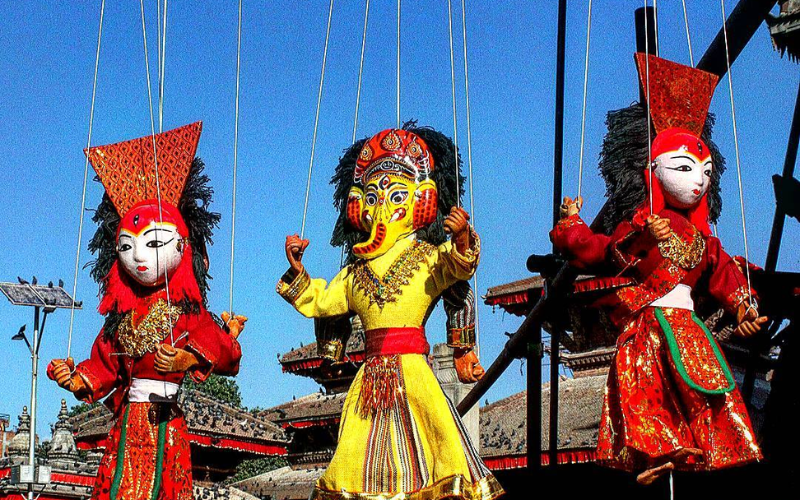Puppetry in Nepal is more than just entertainment—it’s a storytelling tradition that carries centuries of history, artistry, and symbolism. Known locally as Putali Naach (meaning “puppet dance”), this captivating folk art reflects Nepal’s diverse cultural heritage and the creativity of its artisans.
A Glimpse into History
Puppetry in Nepal dates back hundreds of years, influenced by both Hindu and Buddhist storytelling traditions. Traveling performers once used puppets to share moral tales, legends of gods and heroes, and social lessons with village audiences. Long before television or radio, these miniature theatres brought stories to life, blending performance, music, and myth.
Types of Nepali Puppets
There are several traditional forms of puppets found across Nepal, each with distinct styles and techniques:
String Puppets (Putali Naach): These are the most common. Made from cloth, wood, and papier-mâché, the puppets are controlled by strings attached to a wooden crosspiece. Skilled puppeteers can make them dance, bow, and express emotions with surprising realism.
Glove Puppets: Often used in street performances and educational programmes, glove puppets fit over the puppeteer’s hand and are popular for their simplicity and expressiveness.
Shadow Puppets: Though less common, these use flat, cut-out figures projected against a lit screen, creating a magical visual experience.
Symbolism and Stories
Traditional Nepali puppet shows often feature divine and moral tales—stories of Ramayana and Mahabharata, or folk legends featuring gods like Vishnu, Shiva, and Ganesh. Some shows also depict rural life, humour, and social commentary, reflecting everyday struggles and values.

The Art of Puppet-Making
The making of Nepali puppets is itself a delicate art. Artisans handcraft each puppet from natural materials like wood, fabric, and clay, then paint them with vibrant colours. Costumes often mirror traditional Nepali attire—bright saris, dauras, and topis—while facial expressions are exaggerated to convey emotion from a distance.
In places like Bhaktapur, Patan, and Kathmandu’s tourist areas, visitors can find puppet workshops where craftspeople still practise and teach this age-old skill. Many shops also sell hand-painted puppets as souvenirs—symbols of Nepal’s artistic spirit.
Modern Puppetry and Preservation
While traditional puppet shows have declined with modern entertainment, efforts are underway to revive and preserve this cultural heritage. Organisations and theatre groups in Nepal now use puppetry in education, awareness campaigns, and cultural festivals. Puppets are used to teach children about health, environment, and social harmony—keeping the art relevant to today’s world.
Where to Experience Puppetry in Nepal
Visitors can enjoy puppet performances at cultural centres, local fairs, or during traditional festivals. In Kathmandu’s Hanuman Dhoka, Patan Museum, and Bhaktapur Durbar Square, puppet shops and demonstrations often accompany heritage tours, offering a glimpse into this living art.
Puppetry in Nepal is a vibrant expression of the nation’s creativity, spirituality, and storytelling tradition. Though small in size, these handcrafted figures embody big stories—of gods, people, and the timeless connection between art and culture. Whether you see a performance or take home a handmade puppet, you carry with you a piece of Nepal’s living history.
PC: Wikimedia Commons, PxHere
Also Read